Handling & Storing Numismatic Treasures and… Flyspecks?
Some handling and storage methods are known to contribute to the deterioration of coins, lowering values considerably along the way. Beware of this Rare Coins 101 Axiom:
Improper management of a coin collection can promote damage and diminish its value. You can reduce this risk by knowing how to handle raw coins, selecting appropriate holders, and limiting environmental exposure.
If you don’t want the shock of someday discovering that Liberty Seated half dollar in MS-65 you were so pleased with must be seriously downgraded because of its treatment received from you, read the following advice carefully. It could save you tons of mental anguish later on.
- Handle Coins Properly
- Flyspecks
- Environmental Conditions
- Cleaning Your Coins?
- Individual Coin Holders
- Coin Folders
- Coin Albums
- Where to Store Your Coins?
- You are a Temporary Custodian
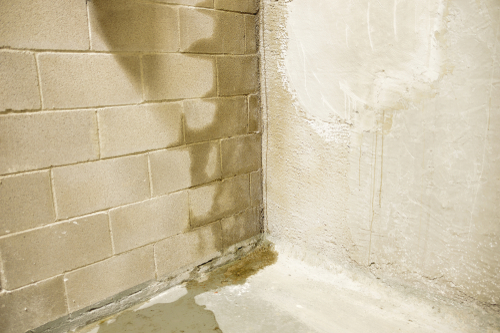
Handle Coins Properly
Never pick up an unprotected collectible coin in any way other than by its edges, between your thumb and index finger (this is one situation where it's okay to use the middle finger, if its more comfortable for you).
If your fingers come in contact with either one of its sides, small amounts of oil and acid in the skin or other contaminants could be left behind that could cause corrosion. Wearing cotton gloves greatly mitigates this concern.
Always place a plush towel or something soft below the coin in case it should accidentally slip from your grasp. There will be a lesser risk of damage by doing so.
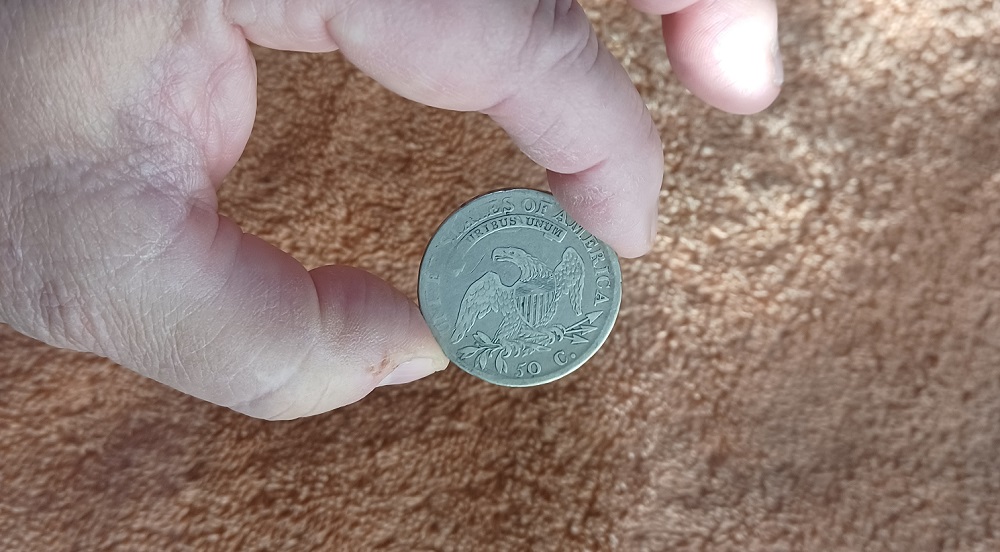
Do not allow any collectible coin to forcibly contact other coins or hard objects. Although we ordinarily think of coins as durable metal and resistant to harm, any bump or scrape could leave scratches. By no means should anyone drag a valuable coin along any surface, no matter how soft or slick the surface is.
As you handle more valuable and/or upper grade coins, this advice increases exponentially in importance. One slight mistake could diminish your coin’s selling price drastically.
Even if you’ve got a heavily worn coin that’s obviously been to Hell and back, it’s still good practice to observe proper handling techniques.
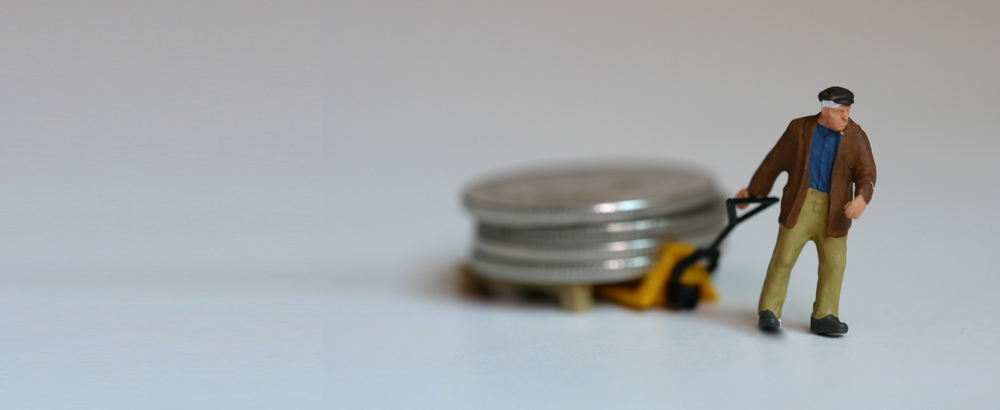
Flyspecks
We all have seen flyspecks, correct? For those who aren’t certain what they are, flyspecks are the result when flies… uhmm … do their business.
In numismatics, the term flyspecks (thankfully!) has a different meaning.
When very small droplets of moisture (frequently from saliva emitted while speaking) come to rest on the surface of a coin, black oxidation spots may occur, resembling flyspecks. This is how the term originated.
Unfortunately, flyspecks subtract from a coin’s eye appeal, so take caution not to say much out loud when you’re handling raw coins (and cover your mouth when sneezing!).

Environmental Conditions
Oxidation and Corrosion
Copper has been used since ancient times in the production of coins. Copper’s ductility (i.e., workability) and durability explain why this metal was (and still is) frequently selected for coinage purposes.(1)
The capacity of a metal to react with its surrounding environment is determined by its atomic structure. Compared to most other elemental metals, copper reacts slowly with the environment, but it does react. Exposure to air, water, sulfur, minerals, industrial fumes, or other matter may initiate an irreversible chemical reaction called oxidation. The resultant oxide compounds forming on a coin's surfaces denotes the beginning of the corrosion process.(2)(3)
Oxidation is the reason why upon exposure to the environment, copper coins usually lose their original red-orange color, morphing into a brownish tone over time.
Some oxidation/corrosion effects can be severe. A good case study is the planchets (sometimes called blanks) used to strike most U.S. half cents and large cents prior to 1835. These planchets were imported from England and were exposed to sea water dampness during their long journey across the Atlantic.(4)
As a consequence, we commonly see many early U.S. coppers afflicted with varying degrees of corrosion. Sometimes the damage is minimal, but all too often these survivors from the infancy years of the United States are characterized by heavy and unsightly corrosive pockmarking. Various terms used to describe this type of corrosion include include: porosity, granularity, and pitting.
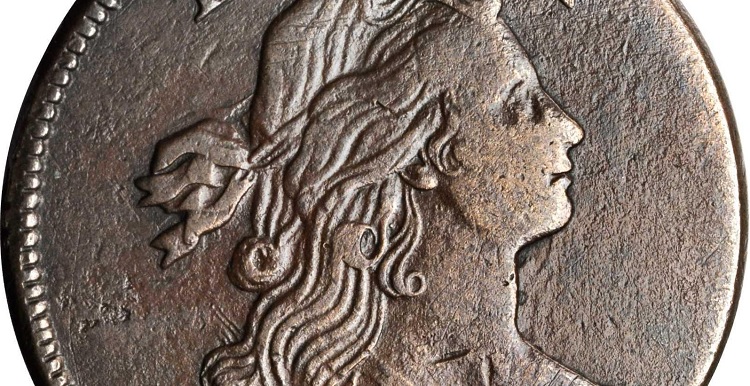
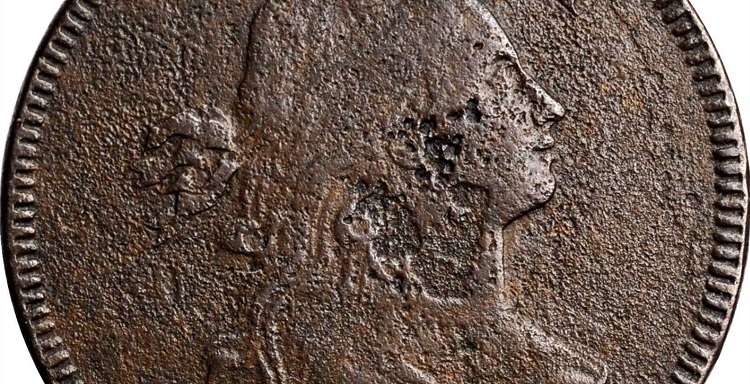
Silver is less reactive than copper and gold is less reactive than silver,(5) but as we are about to learn, coins made predominantly of these precious metals are susceptible to environmental damage as well...
Historically, most United States coins were composed predominately of copper or alloys containing copper. Copper was added to gold and silver coins to make them harder and more suitable for circulation.
Because of the copper content of collectible coins, exposure to certain atmospheric conditions makes them more susceptible to oxidation/corrosion and can literally eat away at their numismatic value.(6)(7)
Nickel, too, is often alloyed with copper in coinage production. For example, the "nickel" began circulating in 1866, composed of 75% copper and 25% nickel. Also, the outer layer of "clad" coinage, which started in 1965 and continues to this day, is of the same metallic composition.
The cupronickel alloy is highly resistant to corrosion, but as this Shield nickel demonstrates, it is not immune to harsh environmental conditions.
Toning
Toning is a term used by numismatists to describe a change in a coin's original coloration due to environmental exposure and ensuing oxidation.
One might think of toning as a bad thing because it technically is an early-stage corrosive action.(8) To be sure, toning often does render a coin less attractive, especially when the oxidation process generates darker colors that dominate the coin's appearance. Unsightly toning is frequently categorized as tarnish.
Ironically, toning is sometimes seen favorably. This occurs when the chemical reactions on the surface of a coin result in colorful rainbow hues that many collectors find attractive. It enhances the "eye appeal" of the coin to the point where these same collectors will pay a handsome premium to acquire it, well above the selling price of the same coin without the toning.
Most of the beautifully toned coins are silver-based. Collectors motivated by attractive toning delight in the spectrum of colors from brilliant blue to vivid magenta, fiery red to intense orange, occasionally complemented by a touch of olive, green, and gold.(9)
Rare Coins 101 has an in-depth essay on eye appeal in another chapter. Toning is not the only factor involved in evaluating eye appeal, but it most certainly is important.
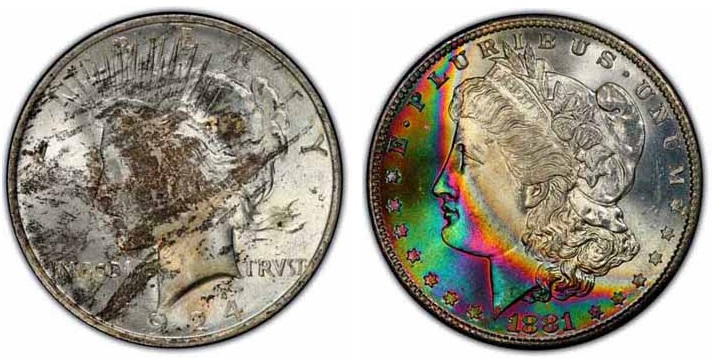
Limiting Environmental Exposure and Damage
Now that we’ve touched upon the basics of how and why your coins may be damaged by their surrounding environment, it is time to discuss what to do about it.
Water is one of the worst corrosion promoters of all. Storage areas should be dry and free from dampness and moisture of any kind, including humidity. Damp basements are notorious for this. If some moisture is inevitable (attention coastline dwellers!), a fresh packet of silica gel stored with your coins will absorb some of the moisture.
The lower the humidity, the better it is for your coins.
Never use paper envelopes for storing coins. Most paper products contain sulfur and acid, which can cause an ugly black or yellow tone to develop on your coins. As an additional precaution, maintain separate storage locations for your important documents and your numismatic holdings.
Chemical fumes can be detrimental to a collection. If your nose detects a chemically induced smell, that’s an immediate clue not to deposit your coins there. That’s why you should never store coins in close proximity to household cleaning supplies. The food pantry and kitchen are bad places for collections too, so don’t try to hide a certified coin slab in a bag of potato chips!
Extreme heat or cold may take their toll on your collection as well. Heat accelerates the negative effects of humidity and chemicals. Cold temperatures can promote condensation and moisture. Therefore, attics and non-insulated garages are poor choices to stash your coins.
Cleaning Your Coins?
Coin cleaning has long been a hot topic of debate among collectors.
Try Googling any subject related to environmentally damaged coins and you will be inundated with product pitches and advice guaranteed to make your coins like new again.
Some “wise sages” claim olive oil or baking soda will magically do the trick every time. One coin forum contributor got really creative, suggesting the action of smearing your verdigris-laden coin with grasshopper eggs while facing east at nighttime would return it to its original color (not really -- this last one was just now made up, but it would not be surprising to find something just as whacky online.)
The truth is many collectors clean their coins. Museum conservator and author Susan Maltby conducted collector surveys in 1992, 2006, and 2016 and discovered at least 60% of the respondents admitted to cleaning their coins.(10) These were not scientifically conducted polls, but the upshot is quite a few collectors are applying active ingredients to their coins in the hope of making them look better.
There could be any number of legitimate explanations why collectors try to clean their coins, but if you are giving that idea some thought, bear in mind this Rare Coins 101 Axiom:
Unless you are a coin restoration expert, never attempt to clean a coin you consider to be valuable.
Successfully cleaning a coin without doing more harm than good requires proper cleansing agents, experience, and talent. Quite a number of the coins recovered from the SS Central America shipwreck were covered with rust, but were expertly cleaned by professional conservators:
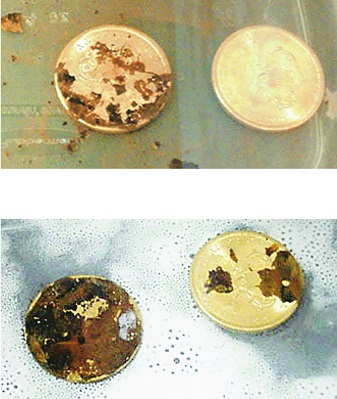
For generations unfortunately, too many well-intentioned coin owners (and some not so well-intentioned) have mistakenly attempted to improve the appearance of their coins by employing improper cleaning techniques. Some of these may look okay to the naked eye, but under magnification, coin experts can usually detect tiny abrasions and/or chemically altered surfaces created as a result of the cleaning activity.
When this happens, these coins are labeled as “problem” coins and almost aways suffer diminished value compared to had they not been cleaned.
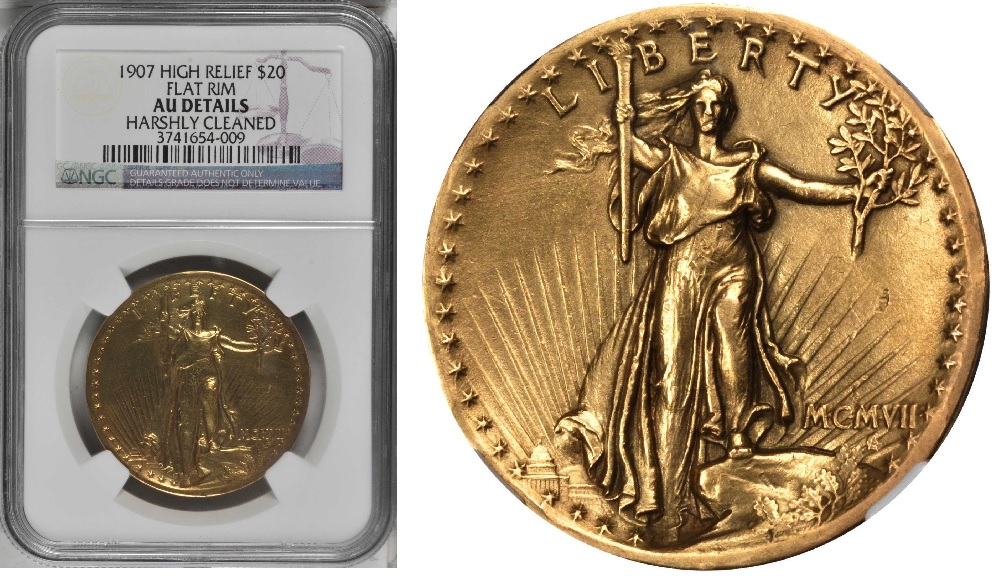
There are times when a coin can and should be cleaned. The coins salvaged from the SS Central America shipwreck (see a few paragraphs above) is one such example.
A coin with PVC residue, dirt, encrustations, artificial toning, or other unattractive adhering matter may be successfully removed without damaging the coin. If done properly, a coin’s eye appeal and value can be improved through cleaning.
Unfortunately, corrosion is irreversible, but it’s possible to stabilize the coin’s surface to limit further harm.
If you’ve got a coin that is a good candidate for cleaning but are not confident in your ability to remove the offending contaminants, it may be wise to turn to a professional coin conservation company.
One of the most respected companies performing this type of work is Numismatic Conservation Services, established in 2001.
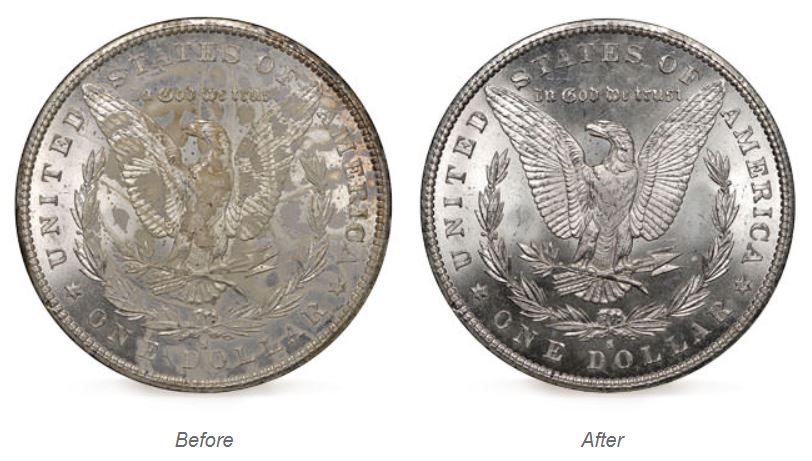
Individual Coin Holders
As an Amazon Affiliate I earn from qualifying purchases, at no added cost to you. Thank you!
Just about any collectible coin should be housed in some type of protective holder. A big percentage of the more valuable coins trading hands these days are professionally graded by PCGS or NGC and are encapsulated in inert hard plastic and nearly airtight holders providing premium protection.
Between PCGS and NGC, they have combined to grade and encapsulate (intuitively) tens of millions of coins,(12) leaving a much larger portion of collectible coins needing protection.
There are many types of holders available from coin supply vendors, ranging widely in shielding capability and cost. We can’t cover all of them here, but let’s look at a few of the most widely distributed products.
Before getting too far into this discussion, please keep this Rare Coins 101 Axiom in mind:
The more airtight a coin storage device is, the better it defends against environmental contamination. The more inert it is, the less likely it will initiate a chemical reaction with the coin(s) it is supposed to protect.
Cardboard Coin Flips
Cardboard coin flips of 2”x 2” size are probably the most common holders today for single coins and have been for more than half a century.
Whoever named this product "coin flip" apparently was not worried about confusing it with the Heads/Tails call most non-collectors think of when hearing about a coin flip.
An unused flip measures 2”x 4”, with the cardboard hinged at the center. The inside of the flip is lined with a transparent, non-scratching inert material called Mylar, also known for its resistance to tearing and moisture. There are centrally located round holes on both ends, so that when the flip is folded and stapled shut with the coin sandwiched in between, the obverse and reverse are visible.
Cardboard coin flips are also available in 1.5”x 1.5” and 2.5”x 2.5” sizes.
If cardboard coin flips meet your collecting needs, Amazon has a wide selection to choose from.
Pros: Inexpensive and perfect for dense, compact storage. The ideal solution for protecting relatively low value collectible coins. The size of round window openings varies to coincide with specific denominations (cent, nickel, etc.) to restrict movement inside the flip.
Cons: Dust from the cardboard can migrate to the coin, possibly causing sulfur contamination and spotting. Not at all airtight. Also, when removing a coin from a cardboard flip, the sharp points on the staples pose a threat to scratching.
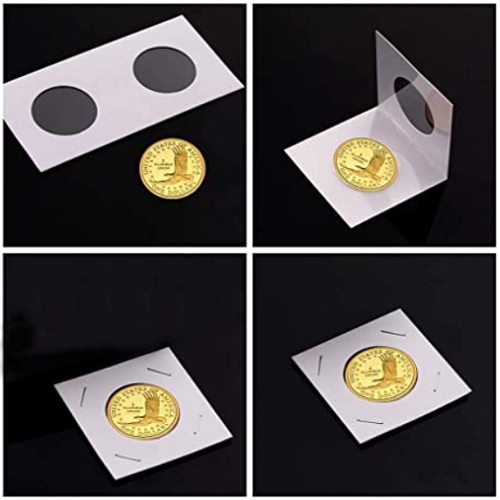
Plastic Coin Flips
Plastic coin flips of 2” x 2” size are also extremely common in any coin collecting setting.
These types of holders are transparent and have two pockets. One pocket is for the coin. The other pocket is available to insert information cards about the coin (price, grade, inventory ID, etc.)
Avoid plastic flips containing polyvinyl chloride (PVC), which is the agent that makes plastic soft and pliable. Unfortunately, PVC sometimes breaks down and leaves a slimy deposit on the coin and promotes corrosion. Flips made of Mylar or another inert material are greatly preferred.
Insist on cards free of acid and sulfur for placement in the information pocket.
Plastic coin flips are also available in 1.5”x 1.5” and 2.5”x 2.5” sizes.
To no one's surprise, there are many plastic coin flips to choose from on Amazon.
Pros: Like their cardboard cousins, plastic coin flips are cheap and conducive for high density storage and suitable for protecting relatively low value collectible coins. Easy to insert or remove coins.
Cons: The ease in which a coin can be removed is also the reason why it can accidentally dislodge from the holder. Coins can easily move around inside the plastic flip. Not at all airtight. Many collectors buy plastic coin flips with PVC, unaware of the dangers posed by this substance.
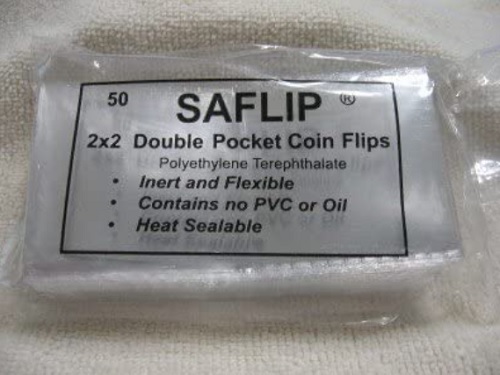
Snaplock Holders
A snaplock holder is a two-piece hard plastic design that snaps together with the coin in the center, displaying both its obverse and reverse.
Snaplock holders composed of inert materials such as acrylic or polystyrene that don’t react with coin metal and are suitable for safe, long-term storage.
Individual snaplock holders typically measure 2”x 2” in overall size, but accommodate specific coin sizes, so be sure you’re ordering the correct size. Some snaplock-style holders are large enough to protect multiple coins.
Get a closer look at snaplock holders HERE.
Pros: Provides very good protection against contact damage and are closer to being airtight to guard against environmental damage. Stackable. Worthy holder for higher value coins.
Cons: A bit more expensive. Thicker than flips, so not as convenient to store multitudes of them. Must use stickers or some other method to record information about the coin inside. Be careful to order the right product for your coin sizes.
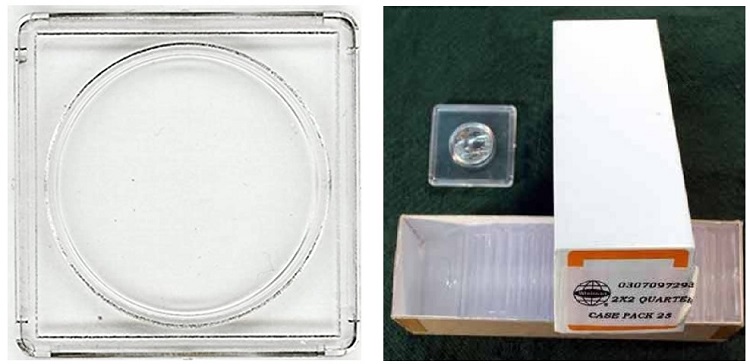
Coin Capsules
Coin capsules are another holder that have been met with generally good reviews. Two hard, inert plastic pieces come together around the coin to create a protective shell, or capsule.
Capsules may be of differing diameters to accommodate coins of various sizes. Other styles maintain a consistent outer diameter and come with foam "gasket" inserts in a range of center diameter openings, designed to snugly fit around whatever the coin inside might be (cent, nickel, dime, etc.)
Other capsules are equipped with rubber gaskets to make them more airtight.
On Amazon, there are coin capsules for every coin size, available at rock-bottom prices.
Pros: Provides very good protection against contact damage and can be nearly airtight to ward against environmental reactions. A good choice for valuable coins held in storage for long periods of time.
Cons: A bit more costly. Not good for attaching information about the coin. More difficult to organize and transport in large quantities compared to flips. Ordering the correct size holder for your coins may be confusing for some.

Premier Slab-like Holders
These resemble the slabs used by professional grading services to encapsulate coins after certification, and are just about the best holder collectors can buy from coin supply companies.
A major difference is PCGS and NGC holders are sealed using sonic welders (not even this process can guarantee a perfectly airtight seal every time) and these commercially obtainable slabs are not.
The unit is assembled by snapping together front and back covers, composed of inert plastic. Enclosed in the holder is a non-reactive decorative insert with a hole to restrict movement of the coin. Inserts are available with various hole sizes, so place your order depending on the type of coins you wish to protect.
The best place to shop for premier coin holders is Amazon because of selection and price.
Pros: These are about the best holders for sale to preserve your most valuable raw coins. They can’t be sealed, but the good thing about that is the coin can be removed without much risk and reused. Additionally, there is a spot for information labels. Very professional appearance.
Cons: Cost is higher than other holders, but well worth it if you have valuable coins to protect. Double check your order for correct coin size.

Coin Folders
As an Amazon Affiliate I earn from qualifying purchases, at no added cost to you. Thank you!
With coin folders, each coin is forced into a round slot with a thin cardboard backing. Many folders are manufactured entirely from paper products.
Most coin folders are dedicated to one type of coin, such as Lincoln cents or state quarters. There is one slot for each date and mint mark of series. The reverses cannot be seen and are at risk of tarnishing from their contact with the paper, and the obverses have little, if any, protection from contact or atmospheric conditions.
Coin folders are suitable only for displaying low value collections.
Coin folders make a perfect gift for collectors just starting out. If you can't find just what you're looking for on Amazon, chances are you won't find it anywhere.
Pros: Very low cost. Highly compact storage. They are good choices for someone just starting out in the hobby with little money to spend. Slots are labeled with dates and sometimes mintages to aid in learning. Attractive covers.
Cons: May take a strong thumb to force coins into slots. Not much coin protection. Ingredients used in manufacturing of low-cost folders may tarnish coins over a period of years.
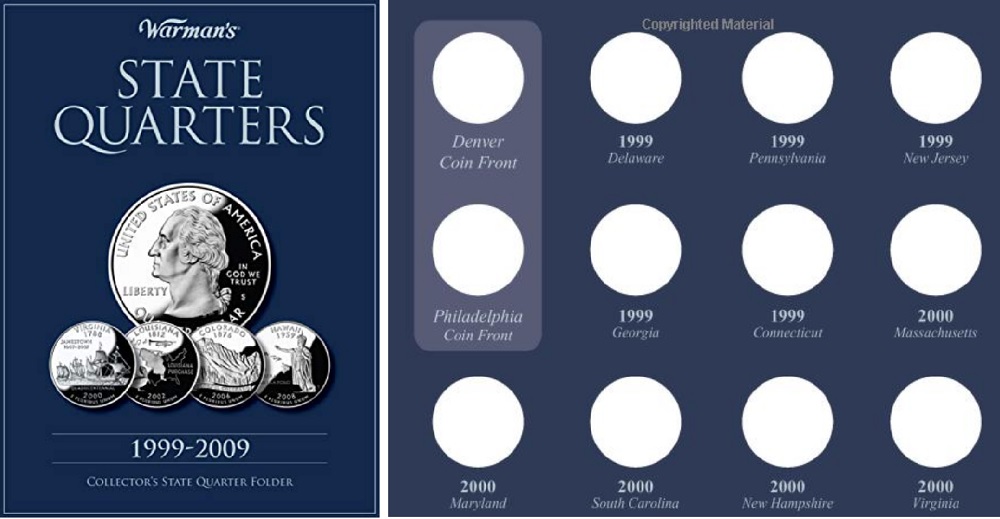
Coin Albums
As an Amazon Affiliate I earn from qualifying purchases, at no added cost to you. Thank you!
Coin albums are a step up from coin folders. They’re organized similarly, but both sides of the coin are viewable while being shielded from contact.
Each album page has rows of coin openings that are covered by transparent slides on both sides of the row. The slides secure the coins in place and allow obverse and reverse inspection. Under each opening is printed the date and mint mark for the coin that is to occupy the opening.
Coin albums are constructed in a way to make it is possible to hold more pages than a folder. Album pages are secured in a binder, but are removable.
Avoid albums containing sulfur, acidic, or PVC materials. These could potentially harm your coins. Retailers normally mention this in their sales pitches, so that’s how you’ll know.
Choose from a wide selection of coin albums on Amazon.
Pros: Coin albums are attractive and well organized. Both sides of coin are visible. Suitable for intermediate collections. Compact storage.
Cons: Much more expensive than folders. Use caution when moving protective slides, as they can scratch high points on the coin. Not recommended for highly graded or rare, valuable coins.

Where to Store Your Coins?
As an Amazon Affiliate I earn from qualifying purchases, at no added cost to you. Thank you!
Now that we know about proper coin handling, various protective holders, and environmental dangers, now comes the question where to store your collection. Is there such thing as an ideal place?
Most of us have a choice between keeping our collections at home or a bank safe deposit box. Even after properly addressing the risks of contact damage and environmental conditions, neither of these are a perfect solution, because both have potential drawbacks.
Home Storage
Many collectors opt to store their coins at home, where they can be efficiently organized and relished on a regular basis at a moment's notice.
Home storage may be more convenient, but fire and theft are perils for the coin collector to consider. However, there are safes designed to mitigate the risks posed by these threats.
fire protection safes
To guard against fire, select an Underwriters Laboratories (UL) 125 rated fireproof safe. These safes are primarily recommended for data/media (DVDs, hard drives, etc.) because they prevent internal temperatures from reaching above 125 degrees Fahrenheit. They are also waterproof and designed for superior humidity control. It just so happens UL 125 safes provide ideal conditions to house coin collections as well.
Not all fireproof safes are the same...
Many of lower cost fire safes are rated for 350 degrees Fahrenheit (intended to protect paper documents), but plastic encapsulations for certified coins have been known to melt in hot cars, so these safes may not provide adequate protection for your coins against fire.
The term "fireproof" is somewhat of a misnomer, because no safe can shield its contents from a 1700-degree Fahrenheit fire indefinitely. In addition to an internal temperature rating, fireproof safes are also rated for how long they can maintain a certain temperature maximum in the midst of a blaze. After that time is up, all bets are off. A more accurate description for this type of safe would be "fire resistant".
UL 125 fireproof safes measuring 1.00 cubic feet storage capacity or less providing for up to one hour of fire protection are common. These are generally priced in the hundreds of dollars. Bigger safes and safes guaranteed to protect its contents for two hours or longer naturally cost much more.
There are cheaper safes that provide fire protection for less than one hour, but that doesn't allow much time to rescue your collection from a fiery inferno, so factor that into your decision.
There are many fire protection safes for sale on Amazon. Carefully review all the specs before making a purchase.
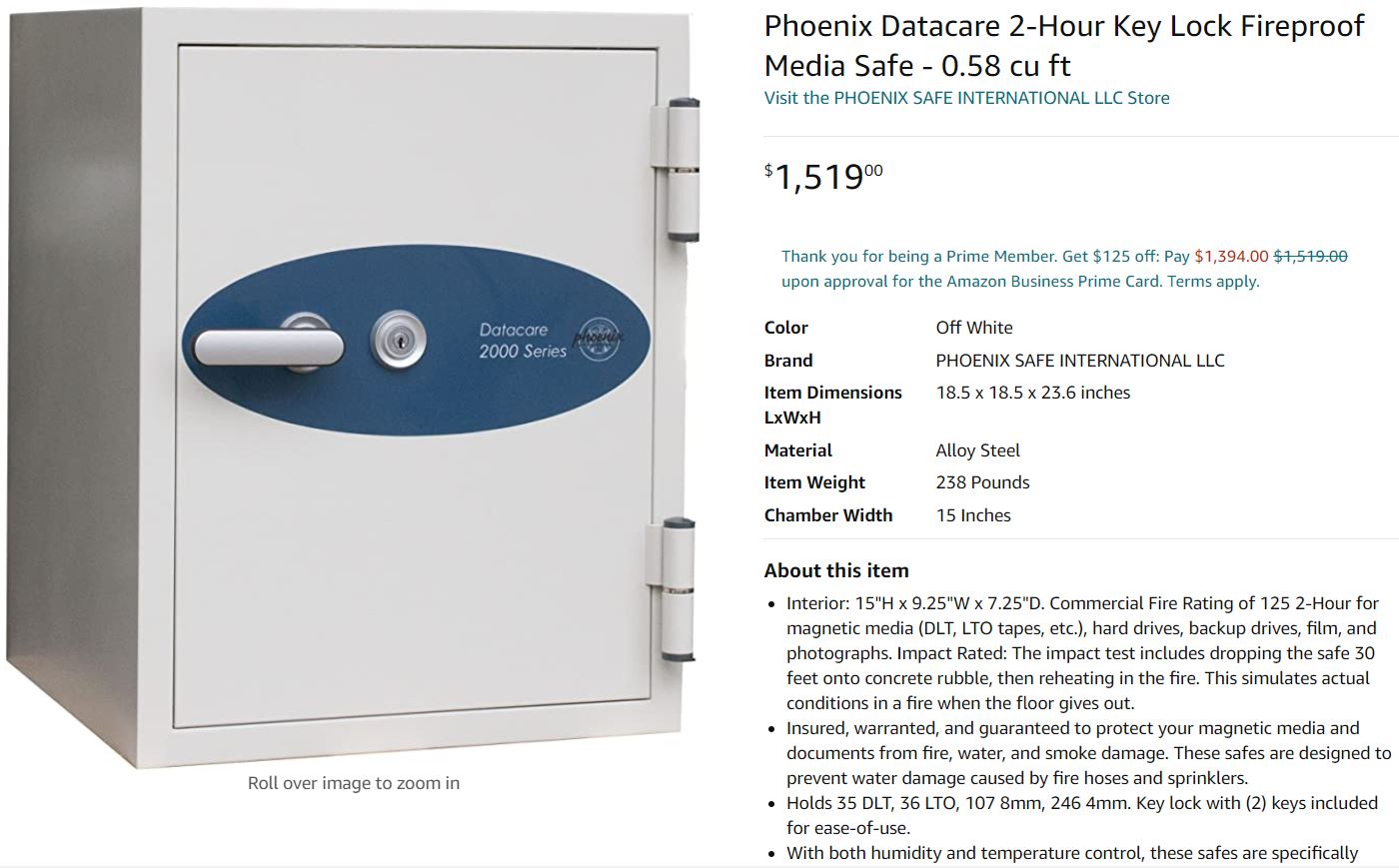
theft protection safes
Fireproof safes may preserve your collection in the event of a fire (or flood), but are not necessarily manufactured to thwart theft.
UL ratings for security safes are determined by how long a safe can resist efforts to break in using carbide-tipped high-speed drill bits, diamond grinding wheels, chisels, pry bars, sledge hammers, and saws.
A safe capable of resisting a break in attempt for 15 minutes gets a TL-15 rating. A safe that holds off a burglar for at least 30 minutes gets a TL-30 rating. There are also ratings as they apply to resistance from a hot torch and the tools listed above.(13)
No matter how high the rating, a security safe can always be carted away unless it’s exceptionally well hidden or fastened securely to an immovable object. A homeowner who has just had a $100,000 collection stolen finds little solace in the fact the robbers will have to work extra hard to crack open the safe after they've secretly hauled it back to their crime nest.
Wall safes were invented with this in mind. Also, some security safes are intended to be bolted from within to floors or walls, making them very difficult to remove without accessing the inside of the safe.
If you believe this is the type of safe that best fits your needs, there is a wide range of quality and sizes available on Amazon.

Fire & theft protection safes
There are many safes advertised to guard against both fire and theft. The problem is virtually none of them provide the necessary level of protection against both threats required for properly housing a valuable coin collection.
There are “burglar resistant” UL 125 fire safes, touting the “UL Residential Security Container” (RSC) rating. A safe awarded this certification means it can stop a thief using small, common hand tools for at least five minutes. This is a very minimal level of security and not recommended if theft is a concern.
And then there are plenty of TL-15, TL-30, or higher rated security safes with a fire-protective cladding added to it. The problem here is the fire rating is almost always no better than UL 350, which permits temps inside the safe to reach 350 degrees Fahrenheit. As was revealed above, many plastic coin holders will begin to liquify under those conditions.
What would be the ideal home safe for coin storage? Here are some requirements:
- UL 125 rating with 1-hour or better fire protection minimum.
- TL-15 or better theft protection.
- Designed to be fastened or affixed to an immovable object.
- While we’re at it, let’s specify an internal capacity of at least 2-cubic feet.
Does anyone know of a safe meeting these requirements? If so, use the Contact Dan page so we can tell everyone about it here.
Bank Safe Deposit Boxes
Coins stored in a bank safe deposit box are generally not susceptible to threats from thieves. In addition, just about every bank is equipped with fire suppression systems.
The smallest bank safe deposit boxes are approximately 3” x 5” x 24”, but much larger ones are often available, capable of holding many coins. Rental for a 10"x 10" x 24" box could cost $200 yearly, or possibly a bit more.(15) That's really not a bad deal.
Toss in a few fresh silica gel packets if humidity could be an issue.
If you choose to insure your collection, you’ll pay less in premiums compared to home storage. That’s welcome news.
The obvious drawback to a safe deposit box is lack of quick access. It will take a special trip to the bank when you feel the need to connect again with your coins, and is limited by banking hours. What’s more, you may not be able to leisurely lounge about as you would at home while at the bank.
Also, make sure the bank allows for storage of coins in their boxes. Most banks do, but some do not.
Perhaps a good compromise for you is to create a set registry before dropping them off at the bank? Learn more about set registries.
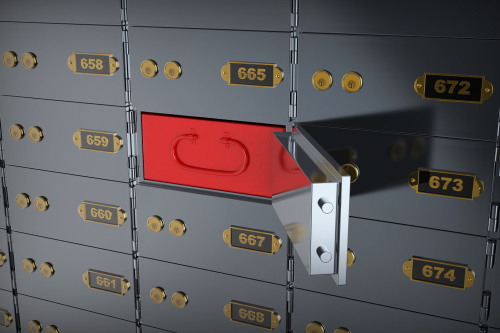
You are the Final Judge
Ultimately, you are the final judge on where and how to store your coins. Thinking in rational terms, however, your strategy should depend on the value and physical size of your collection.
For example, if your collection consists of a few folders filled with low value coins, it would make sense to keep them at home (but not in a damp basement under a bottle of Lysol). On the other hand, if you are the proud owner of a 1794 Flowing Hair silver dollar, a bank safe deposit box or some other very secure location should be utilized.
Here’s how I do it…
I have a safe deposit box at my bank where I maintain my better coins. The vault where the boxes are kept is protected by up-to-date technology, so I never lose a moment’s sleep over their safety. I retain records and photos of every coin to “stay in touch” with them, but if the yearning arises, they are just 15 minutes away by car.
I do keep a few coins at home, ranging in value from a few cents to several hundred dollars each. Included in this number are some of my childhood favorites that bring back happy memories. There is also my War of 1812 collection just at arm’s length, whispering to me daily from the chronicles of history. These are the coins I prefer to remain close to me in my home. If something terrible were to happen to them, I would be heartbroken, but not devasted financially.
You are a Temporary Custodian
Protecting your coins from damage and subsequent value erosion should rank high on your priority list, whether you’re a collector, an investor, or both.
If that’s not enough incentive to motivate you, consider the subject in this regard: Although you are currently the owner of your coins, you are in reality only their temporary custodian, just as all the owners previous to you were. In an ethical sense, we have a responsibility to preserve our numismatic inheritance for future generations of coin enthusiasts.
Someday your collection will be passed on to your heirs or sold to someone who may be a complete stranger. In either event, the new custodians will be wholeheartedly grateful for your thoughtfulness and foresight in preserving another wonderful slice of Americana.
Your coins are not only important to you, they will be important to the people of the future as well.

Quick Links to Other "Getting Started in Coin Collecting" Chapters...
The next chapter in this section is Coin Lingo.
Use the links directly below to navigate the "Getting Started in Coin Collecting" section.
- Coin Grading Basics
- Absorb Knowledge and Stay Current
- What to Collect?
- Understanding Quality
- Develop a Passion for Coins
- Get to Know People
- Handling & Storing Numismatic Treasures (the current chapter)
- Coin Lingo
- Best Places to Buy Coins
All the chapters referenced above are accessible from any other chapter in this section. Thus, no need to return to the "Getting Started in Coin Collecting" Introductory page to link to other chapters.
Sources
1. Copper Development Association. Copper has Played a Key Role in the History of Coins.
2. Vendantu Online: Reactivity Series.
3. Copper Development Association. Copper Reactivity: Patination.
4. Coin Week Podcast #133: Early US Copper Planchets (with Bill Eckberg)
5. Vendantu Online: Reactivity Series.
6. The Spruce Crafts. What Is Coin Toning and Its Effect on Value?
7. Gainsville Coins. Why Does Silver Tarnish?
8. Coin Community Form. What Exactly Is Corrosion On A Coin?
9. Cable Shopping Network. All About Coin Toning.
10. Coin World Magazine. Preserving Collectibles 08-29-2016, by Susan Maltby.
11. Gibbs, William T., Managing Editor. Coin World Domestic Values. Sidney, OH. Amos Media Company. 2016.
12. NGC Coin Buying Guide -- How many coins has the grading service certified?
13. Coin World Magazine. Decisions about home safe need serious consideration. 09-12-2014, by Susan Maltby.
14. Collectors Universe U.S. Coin Forum. At what temperature does slab plastic melt?
15. Value Penguin. The Average Cost of a Safety Deposit Box.

